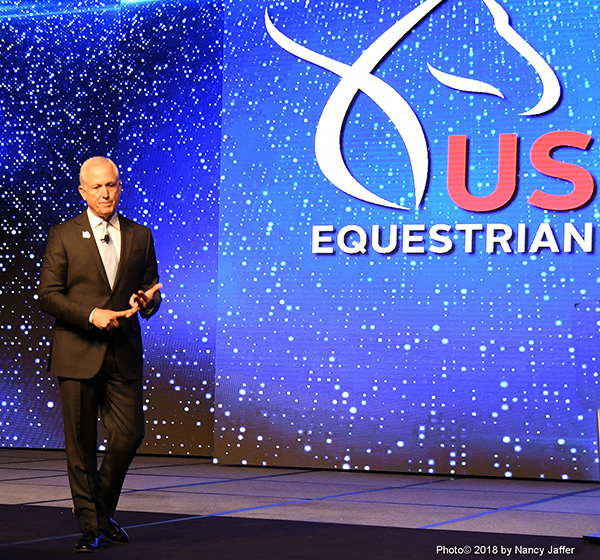The annual meeting of U.S. equestrian sports’ governing body used to be a big yawn. Literally.
From the days when the organization was the American Horse Shows Association, through its transformation into USA Equestrian in the late 1990s, it often became a struggle to stay awake during rule change forums. The exceptions were the few-and-far-between exciting topics, such as mandating safety helmets or prohibiting certain popular “medications” in competition.
Although discussions went on endlessly, it sometimes happened that even when everyone in the room agreed on the wording of a rule, it would come out in the rulebook as something different. The old line folks, the big names of yesteryear, were still running things the way they wanted to run them.
The rank and file often found they weren’t being heard, and eventually, many stopped attending. The only highlights would be the galas, such as for the Horse of the Year awards, or field trips to different farms and equestrian locations for more partying.
It was easier to stay awake in the early 2000s, as the U.S. Equestrian Team and USA Equestrian battled for supremacy, to see which would be the sport’s national governing body – all while the gossip mill was grinding out titillating rumors.
But two or three years after formation of the U.S. Equestrian Federation (when the USET became a foundation that raised money for international competition) the conventions were slipping into sleepy time again.
And then in 2017, energetic former corporate CEO Murray Kessler took over as president. He woke up everyone. An amateur jumper rider, (whose daughter, Reed, set a record by being the youngest Olympic show jumping rider in history when she made the 2012 team at age 18) Murray’s dynamism was contagious.
He rebranded USEF as the more user-friendly U.S. Equestrian when referring to the sport angle of the organization’s business, and made a lot of promises at the 2017 convention, the first where he presided. They included growing the membership, boosting sponsorship and raising the profile of horse sports to increase both even more.
At the 2018 convention, which ended Saturday in Lexington, Ky., we learned a lot of what he promised had been realized. Membership grew from the figure of 80,000 or so where it had been static for years, to about 105,000. Granted, that higher figure was to some extent a result of $25 fan memberships (you get all the membership benefits except being able to compete in recognized shows) and some were given away. But the idea was to introduce the perks of membership so people would come back and enroll as full members at a fee (just raised) of $80.
Not all the news was good news, though. A mistake in the federation’s drug testing laboratory reversed the suspensions and fines of a high-profile trainer and hunter rider accused in connection with a horse testing positive for a prohibited substance. The federation already is undertaking an audit to determine exactly what happened, in order to make sure it doesn’t happen again.
The annual meeting was jazzed by a variety of lively videos and their catchy soundtracks, recounting the gains of the past year and also highlighting serious matters, including the federation’s efforts to help horses that were victims of such tragedies as the major hurricanes and forest fires that were rampant in 2017.
The bells and whistles, however, didn’t overshadow efforts to make real changes in big picture issues involving how the sport is run. For instance, although there has been talk for years about the necessity of contracts for horse sales or having the federation play a role to prevent abuses that too often are a part of those sales, those efforts never went anywhere.
This time, a proposal that would have made fraudulent behavior related to horse sale or lease transactions a violation of USEF rules actually was proposed. True, it was withdrawn after discussion because it needed more work. But I don’t think it will die.
“I get the most calls on fraudulent transactions for horses,” said Murray, who doesn’t understand why people “who buy something more expensive than their home” often don’t bother to do it “on something more than a handshake.”
Philip Richter, a USEF board member who is also treasurer of the U.S. Equestrian Team Foundation, noted that the crooks hurt the whole sport.
“When people get burned [in a transaction] it’s hard to approach them for a donation,” he said, referring to the foundation money that’s used to fuel high performance programs.
Concerns about such a rule include what it would cost USEF and difficulty in enforcing it.
USEF Vice President Elisabeth Goth sees the rule as “a way to get a hearing without spending lots of money” on a lawsuit.
Murray wants more background on how this should be approached, but he will appoint a task force to come up with ideas. Showing that he’s serious, Murray set a deadline of the board’s mid-year meeting this summer to take another look after a “strategic analysis” has been accomplished.
There is no doubt that more work is necessary on both the concept and the language. But it could be groundbreaking as a way to address one of the problems in the sport that no one really wants to talk about – until it affects them. And passing it would show that USEF means business when it comes to doing things that really matter for the good of equestrian sport.
As Murray put it, “Let’s do the work on something that matters.”
by Nancy Jaffer

